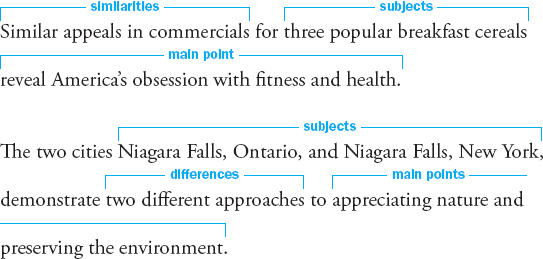CHARACTERISTICS OF COMPARISON AND CONTRAST ESSAYS
Whether used as the primary pattern of development or alongside other patterns, successful comparison and contrast writing generally meets several criteria.
COMPARISON AND CONTRAST HAS A CLEAR PURPOSE AND IS WRITTEN FOR A SPECIFIC AUDIENCE
A comparison and contrast essay usually has one of three purposes:
- To express ideas: The purpose of an essay about playing Rockband could be to express the writer’s love of the game, rock music, or both. The audience for this essay might be the readers of an online forum for the discussion of video games.
- To inform: The purpose of an essay about playing Rockband could be to inform readers new to the game how playing Rockband differs from playing in a real band. The audience for this essay might be dedicated amateur musicians looking for an electronic alternative to joining a band.
- To persuade: The purpose of an essay about playing Rockband could be to persuade readers that Rockband is much more challenging in some ways than playing in an actual band. The audience for this essay might be musicians who think the game seems easy.
COMPARISON AND CONTRAST CONSIDERS SHARED CHARACTERISTICS
You cannot compare or contrast two things unless they have something in common. When making a comparison, a writer needs to choose a basis of comparison — a fairly broad common characteristic on which to base the essay. The paragraph you wrote comparing the Rockband game to an actual rock band may have focused on the similarities and differences in equipment required, physical exertion involved, and so forth. For another essay comparing baseball and football, for example, a basis of comparison might be the athletic skills required or the rules and logistics of each sport.
To develop a comparison-contrast essay, the writer examines two subjects using points of comparison — characteristics relating to the basis of comparison. In an essay using athletic skills as a basis of comparison, for example, points of comparison might be height and weight requirements, running skills, and hand-eye coordination. In an essay based on rules and logistics, points of comparison might include scoring, equipment, and playing fields.
COMPARISON AND CONTRAST IS ORGANIZED POINT BY POINT OR SUBJECT BY SUBJECT
You probably organized your paragraph comparing playing Rockband and playing in an actual band in one of two ways.
- Writing about playing the game and then writing about playing in an actual band (or vice versa)
- Discussing each point of similarity or difference with examples from Rockband and playing in an actual band
Most comparison and contrast essays use one of these two primary methods of organization:

COMPARISON AND CONTRAST FAIRLY EXAMINES SIMILARITIES, DIFFERENCES, OR BOTH
Depending on their purpose and audience, writers using comparison and contrast may focus on similarities, differences, or both. In an essay intended to persuade readers that performers Beyoncé Knowles and Jennifer Lopez have much in common in terms of talent and cultural influence, the writer would focus on similarities: hit records, millions of fans, and parts in movies. An essay intended to inform readers about the singers would probably cover both similarities and differences, discussing the singers’ different childhoods or singing styles.
An essay focusing on similarities often mentions a few differences, usually in the introduction, to let readers know the writer is aware of the differences. Conversely, an essay that focuses on differences might mention a few similarities.
Whether you cover similarities, differences, or both in an essay, you should strive to treat your subjects fairly. Relevant information should not be purposely omitted to show one subject in a more favorable light. In an essay about Knowles and Lopez, for instance, you should not leave out information about Lopez’s charity work while mentioning Knowles’s charitable causes in an effort to make Knowles appear to be the more charitable person.
COMPARISON AND CONTRAST MAKES A POINT
A successful comparison and contrast essay has a main point that sparks readers’ interest in the subjects rather than boring them with a mechanical listing of similarities or differences. This main point can serve as the thesis for the essay, or the thesis can be implied in the writer’s choice of details.
An explicit thesis has three functions:
- To identify the subjects being compared or contrasted
- To suggest whether the focus is on similarities, differences, or both
- To state the main point of the comparison or contrast
The following two sample theses meet all three criteria. Note, too, that each thesis suggests why the comparison or contrast is meaningful and worth reading about.

COMPARISON AND CONTRAST CONSIDERS SIGNIFICANT AND RELEVANT SHARED CHARACTERISTICS
A comparison and contrast essay considers characteristics that readers will find significant as well as relevant to the essay’s purpose and thesis. In general, college writers should discuss at least three or four significant characteristics to support the thesis, describing or explaining each characteristic in detail so that readers can grasp the main point of the comparison or contrast. Writers often use sensory details, dialogue, examples, expert testimony, and other kinds of evidence to convince readers that the items being compared (or contrasted) are, in fact, similar (or dissimilar).
The following readings demonstrate the techniques discussed above for writing effective comparison and contrast essays. The first reading is annotated to show how Greg Beato uses these techniques to contrast The Onion with more conventional newspapers. As you read the second essay, try to identify for yourself how Ian Frazier uses the techniques of comparison and contrast to demonstrate the benefits of pay phones over cell phones.